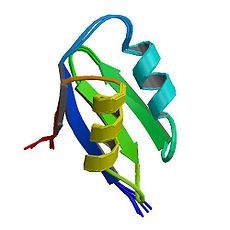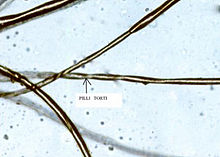- Menkes disease
-
Menkes disease Classification and external resources 
ATP7AICD-10 E83.0 ICD-9 759.89 OMIM 309400 DiseasesDB 8029 eMedicine neuro/569 ped/1417 derm/715 MeSH D007706 Menkes disease (MNK), also called Menkes syndrome, copper transport disease, steely hair disease, kinky hair disease, or Menkes kinky hair syndrome,[1][2] is a disorder that affects copper levels in the body,[3] leading to copper deficiency.[4] It is an x-linked recessive disorder, and is therefore considerably more common in males: females require two defective alleles to develop the disease.
The disorder was originally described by John Hans Menkes et al. in 1962.[5]
Contents
Characteristics
MNK is characterized by sparse and coarse hair, growth failure, and deterioration of the nervous system. Onset of Menkes syndrome typically begins during infancy. Signs and symptoms of this disorder include weak muscle tone (hypotonia), sagging facial features, seizures, mental retardation, and developmental delay. The patients have brittle hair and metaphyseal widening. In rare cases, symptoms begin later in childhood and are less severe. Affected infants may be born prematurely. Symptoms appear during infancy and are largely a result of abnormal intestinal copper absorption with secondary deficiency in copper-dependent mitochondrial enzymes. Normal or slightly slowed development may proceed for 2 to 3 months, and then there will be severe developmental delay and a loss of early developmental skills. Menkes Disease is also characterized by seizures, failure to thrive, subnormal body temperature, and strikingly peculiar hair, which is kinky, colorless or steel-colored, and easily broken. There can be extensive neurodegeneration in the gray matter of the brain.[6] Arteries in the brain can also be twisted with frayed and split inner walls. This can lead to rupture or blockage of the arteries. Weakened bones (osteoporosis) may result in fractures.
Occipital horn syndrome (sometimes called X-linked cutis laxa or Ehlers-Danlos type 9[7]), is a mild form of Menkes syndrome that begins in early to middle childhood. It is characterized by calcium deposits in a bone at the base of the skull (occipital bone), coarse hair, and loose skin and joints.
Cause and Genetics
Mutations in the ATP7A gene, located on chromosome Xq12-q13,[8] are the cause of Menkes syndrome.[9] This condition is inherited in an X-linked recessive pattern.[10] As the result of a mutation in the ATP7A gene, copper is poorly distributed to cells in the body. Copper accumulates in some tissues, such as the small intestine and kidneys, while the brain and other tissues have unusually low levels. The decreased supply of copper can reduce the activity of numerous copper-containing enzymes that are necessary for the structure and function of bone, skin, hair, blood vessels and the nervous system such as lysyl oxidase.
Diagnosis and Treatment
Urine homovanillic acid/vanillylmandelic acid ratio has been proposed as a screening tool to support earlier detection.[11] Early treatment with subcutaneous (under the skin) or intravenous (in a vein) injections of copper supplements (in the form of acetate salts) may be of some benefit.[12] Other treatment is symptomatic and supportive.
Epidemiology
One European study reported a rate of 1 in 254,000;[13] a Japanese study reported a rate of 1 in 357,143.[14]
See also
- Folliculitis decalvans
- List of cutaneous conditions
References
- ^ Online 'Mendelian Inheritance in Man' (OMIM) 309400
- ^ James, William; Berger, Timothy; Elston, Dirk (2005). Andrews' Diseases of the Skin: Clinical Dermatology. (10th ed.). Saunders. p. 765. ISBN 0-7216-2921-0.
- ^ "Menkes syndrome" at Dorland's Medical Dictionary
- ^ de Bie P, Muller P, Wijmenga C, Klomp LW (Nov 2007). "Molecular pathogenesis of Wilson and Menkes disease: correlation of mutations with molecular defects and disease phenotypes" (Free full text). J. Med. Genet. 44 (11): 673–688. doi:10.1136/jmg.2007.052746. PMC 2752173. PMID 17717039. http://jmg.bmj.com/cgi/pmidlookup?view=long&pmid=17717039.
- ^ Menkes JH, Alter M, Steigleder GK, Weakley DR, Sung JH (1962). "A sex-linked recessive disorder with retardation of growth, peculiar hair, and focal cerebral and cerebellar degeneration". Pediatrics 29: 764–779. PMID 14472668.
- ^ Barnes N, Tsivkovskii R, Tsivkovskaia N, Lutsenko S (2005). "The copper-transporting ATPases, menkes and wilson disease proteins, have distinct roles in adult and developing cerebellum". J Biol Chem 280 (10): 9640–5. doi:10.1074/jbc.M413840200. PMID 15634671.
- ^ http://emedicine.medscape.com/article/1180460-overview
- ^ Online 'Mendelian Inheritance in Man' (OMIM) 300011
- ^ Voskoboinik I, Camakaris J (2002). "Menkes copper-translocating P-type ATPase (ATP7A): biochemical and cell biology properties, and role in Menkes disease". J Bioenerg Biomembr 34 (5): 363–71. doi:10.1023/A:1021250003104. PMID 12539963.
- ^ Kim BE, Smith K, Meagher CK, Petris MJ (November 2002). "A conditional mutation affecting localization of the Menkes disease copper ATPase. Suppression by copper supplementation". J. Biol. Chem. 277 (46): 44079–84. doi:10.1074/jbc.M208737200. PMID 12221109. http://www.jbc.org/cgi/pmidlookup?view=long&pmid=12221109.
- ^ Matsuo M, Tasaki R, Kodama H, Hamasaki Y (2005). "Screening for Menkes disease using the urine HVA/VMA ratio". J. Inherit. Metab. Dis. 28 (1): 89–93. doi:10.1007/s10545-005-5083-6. PMID 15702409.
- ^ Kaler SG, Holmes CS, Goldstein DS, et al. (February 2008). "Neonatal diagnosis and treatment of Menkes disease". N. Engl. J. Med. 358 (6): 605–14. doi:10.1056/NEJMoa070613. PMID 18256395. http://content.nejm.org/cgi/pmidlookup?view=short&pmid=18256395&promo=ONFLNS19.
- ^ Tønnesen T, Kleijer WJ, Horn N (February 1991). "Incidence of Menkes disease". Hum. Genet. 86 (4): 408–10. doi:10.1007/BF00201846. PMID 1999344.
- ^ Gu YH, Kodama H, Shiga K, Nakata S, Yanagawa Y, Ozawa H (2005). "A survey of Japanese patients with Menkes disease from 1990 to 2003: incidence and early signs before typical symptomatic onset, pointing the way to earlier diagnosis". J. Inherit. Metab. Dis. 28 (4): 473–8. doi:10.1007/s10545-005-0473-3. PMID 15902550.
External links
- GeneReviews/NCBI/NIH/UW entry on ATP7A-Related Copper Transport Disorders
 Media related to menkes disease at Wikimedia Commons
Media related to menkes disease at Wikimedia Commons
Inborn error of metal metabolism (E83, 275) Transition metal high: Primary iron overload disorder: Hemochromatosis/HFE1 · Juvenile/HFE2 · HFE3 · African iron overload/HFE4 · Aceruloplasminemia · Atransferrinemia · Hemosiderosisdeficiency: Iron deficiencyCuZnhigh: Zinc toxicitydeficiency: Acrodermatitis enteropathicaElectrolyte see Template:Water-electrolyte imbalance and acid-base imbalancehigh: Hyperphosphatemiahigh: Hypermagnesemiadeficiency: Hypomagnesemiahigh: Hypercalcaemia · Milk-alkali syndrome (Burnett's) · Calcinosis (Calciphylaxis, Calcinosis cutis) · Calcification (Metastatic calcification, Dystrophic calcification) · Familial hypocalciuric hypercalcemiaM: NUT
cof, enz, met
noco, nuvi, sysi/epon, met
drug(A8/11/12)
Genetic disorder, membrane: ATPase disorders ATP1 ATP2 ATP2A1 (Brody myopathy) · ATP2A2 (Darier's disease, Acrokeratosis verruciformis) · ATP2C1 (Hailey–Hailey disease)ATP7 ATP13 Other Categories:- Conditions of the skin appendages
- Inborn errors of metal metabolism
- Rare diseases
- X-linked recessive disorders
Wikimedia Foundation. 2010.


